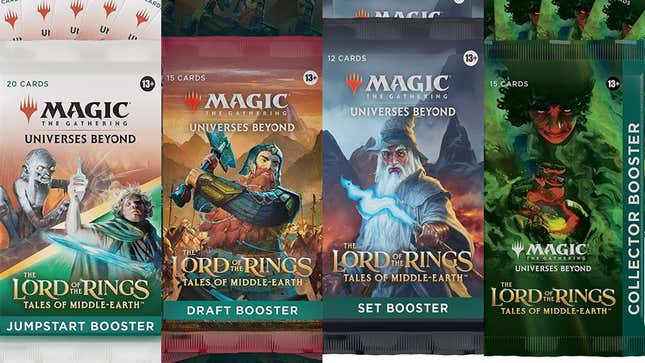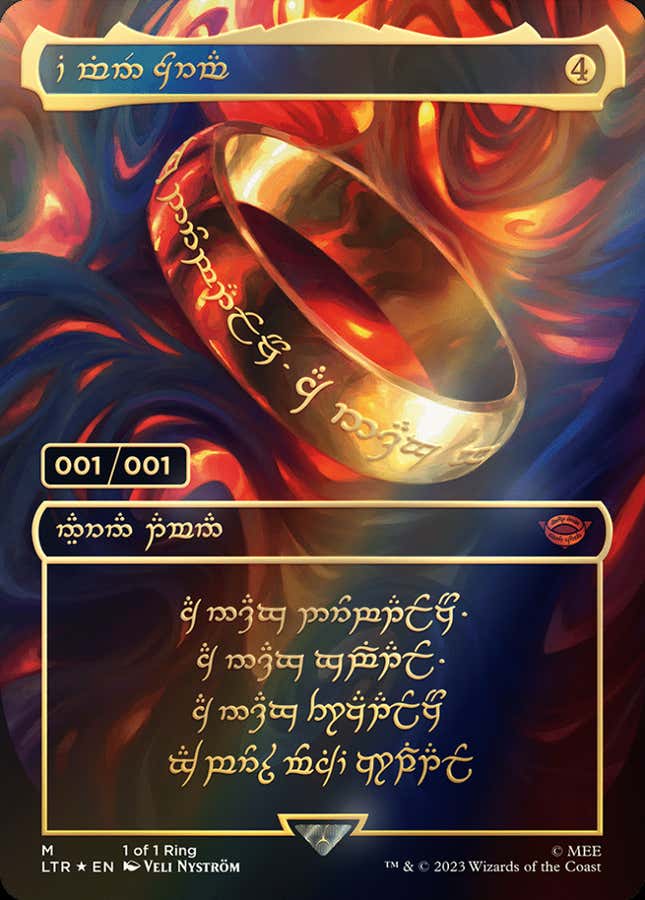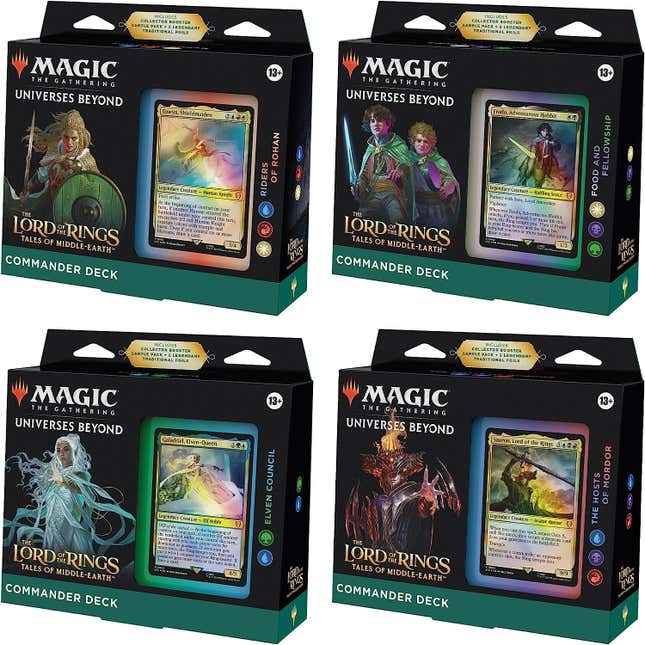Today Wizards of the Coast launched one of the biggest external collaborations it has ever done with Magic: The Gathering—Tales of Middle-earth, an entire expansion dedicated to the world of Tolkien’s beloved fantasy works. If you’re a Lord of the Rings fan intrigued by all the gorgeous art, but a Magic neophyte, we have you covered.
What Is Magic the Gathering: Tales of Middle-earth?
Tales of Middle-earth is the first major release of its scope in a Magic: The Gathering sub-theme called Universes Beyond. Created after Wizards of the Coast did a similar collaborative set for Magic with Dungeons & Dragons called Adventures in the Forgotten Realms (and a smaller follow up, The Battle for Baldur’s Gate), Universes Beyond is now the official home for any external collaboration Wizards does for Magic.
There have been a few releases so far—special cards for Wizard’s “Secret Lair” drop collection have collaborated with the likes of Fortnite and The Walking Dead; there have also been decks for Magic’s Commander format (more on that later) for Warhammer 40,000, and upcoming products include Doctor Who, Final Fantasy, and more. But Tales from Middle-earth is definitely the biggest so far—with 281 cards, it’s on par with a traditional Magic expansion, and comes released in a bunch of product types that can be a little daunting for Magic newcomers.
Where to Start With Tales of Middle-earth
Extremely good news for those newcomers though: if you just want to get started with Magic, literally begin with the Starter set! This is a two-deck bundle that costs around $20, and comes with a how-to-play guide—as both a physical booklet and access to an online interactive tutorial—boxes to keep them in, and even two sets of codes so you and a friend can unlock both decks in Magic The Gathering: Arena, the mobile/PC digital version of the game.
The two included decks are naturally themed around the forces of good and evil seen in Lord of the Rings: one including iconic heroes such as Aragorn and Arwen, Galadriel and Gandalf, and of course a hobbit or two, and the other helmed by cards themed around Sauron and his agents, and the sinister orc armies of Mordor. As a LOTR fan, you’ll get a nice, contained way to learn and play Magic, and explore the theming you’re interested in—and if that’s all you want to do, you can leave it there.

Next Steps: Collecting the Set
But! Perhaps you’ve seen all that pretty artwork and gone a bit Gollum. What if we wants more, precious? Your Magic/Lord of the Rings journey can go one of two ways after the starter set: either you try to chase as many cards in Tales of Middle-earth as possible, or you try to dig deeper into Magic yourself and start using the cards you’ve acquired to build your own decks.
Let’s start with a purely collecting standpoint first. Every Magic set, Tales of Middle-earth included, spreads its cards across a variety of booster packs:
- Jumpstart Boosters: These 20-card packs are designed for super quick deck construction: you buy two, shuffle them together, and you have a reasonably viable deck to play against another opponent’s jumpstart deck.
- Draft Boosters: These are usually aimed at people more experienced with Magic, who don’t necessarily care about a chance at rare versions of cards in the set but just need raw options to build and tweak their decks. There’s 15 cards in each pack, and while they’re intended to be aimed at experienced deck builders, you can still buy them as a way to round out your own collection.
- Set Boosters: Set Boosters are almost identical to Draft Boosters, but they have fewer cards (12 per pack), tend to cost slightly more, and also have more guaranteed chances at rare cards and alternative art variants. If you’re not looking to chase the full set and just want some nice Lord of the Rings cards, these are a good option.
- Collector Boosters: The last and most expensive option, but… hang on, hear us out.
You Don’t Need to Buy Collector Boosters, Especially for Tales of Middle-earth
Collector Boosters were introduced to Magic in 2019, and are essentially a mirror to Draft Boosters but for, well, people who want to collect the rare cards and art variants in a set. There’s 15 cards in a pack, and while they were introduced at costing an already-pretty-high $13, more often than not they now retail for $20-25 per pack (Wizards removed MSRP standards from Magic sets just one month after it introduced Collector Boosters. Do with that information what you will).
Why the high price? Because Collector Boosters have a much, much higher ratio of rarer cards and special variants in them. A single booster is made up of roughly two thirds of cards of the “uncommon” rarity or higher, guaranteed foil versions, and at least one special “Full Art” card, designed to be combined with others to create a larger picture. They’re a sure-fire way to spend a lot of money in a short amount of time if you’re trying to chase cards, but for Tales of Middle-earth in particular, they’re even more of a headache at the moment. Tales of Middle-earth Collector Boosters are the only way to find several of the rarest cards in the set: special, numbered “Serialized” versions of the Human, Elvish, and Dwarven rings of power. While these cards exist in other forms throughout the set, these limited numbered cards are extremely rare.

And of course, this is Lord of the Rings, so another was forged in secret: there is a special variant of the One Ring in Tales of Middle-earth Collectors Boosters of which there is only one in the entire world. A chance at this ultimate card has sent aftermarket prices on Collector Boosters skyrocketing by the bucketload—as of right now, a box of 12 boosters is going for almost $450 on Amazon—as collectors and hobby shops offer high-price bounties to anyone willing to give them the card, if they find it. There’s a parallel here between capitalism and the temptations of Sauron’s most evil creation, but hmm, I just can’t put my ring-finger on it.
Anyway, as a newcomer you absolutely do not need to focus on Collector Boosters as a way to get yourself some Lord of the Rings cards. Just like the One Ring itself, there is temptation in wanting guaranteed access to the shiniest of cards (in the foil variants’ cases, literally), but the bang for your brandybuck just isn’t worth it if you’re looking to actually build out a collection of cards. You can always buy one or two later down the line to chase alternate card art or other variants, but for now, resist. Pass the test, diminish, go into the West, and remain Galadriel, my friends.
Next Steps: Learning Magic
If you want to use the Lord of the Rings hook to actually get into playing Magic rather than just collect these specific cards, there’s pros and cons. As a special collaboration set, while Tales of Middle-earth uses standard Magic rules and effects, the cards themselves are not intended to be played in standard play formats against most other Magic sets. For most people this won’t matter—you want to play with the Lord of the Rings cards against other people using Lord of the Rings cards, because it’s Lord of the Rings. And you can do that! But if you want to expand your Magic knowledge beyond Middle-earth, you’ll need to look to other card sets.
But that doesn’t mean you can’t build out your knowhow solely within Tales of Middle-earth cards. Beyond the Starter kit, we’ve already mentioned a few ways you can start building up a set of cards to build your own deck with: Jumpstart Boosters for quick-and-easy randomized decks (although you will need to add land cards, the subset of Magic cards that provide the resources you need to play other cards, to get a viable deck), or draft boosters to give you more refined options. There’s also a special bundle pack for Tales of Middle-Earth available that includes eight Set Boosters, some unique alternate art cards depicting Frodo, Sam, and Gollum’s struggle atop Mount Doom, 40 Land cards, a special life counter, and then a box to keep all your cards in. After the Starter Set, this is a great way to expand your collection before you look at either tweaking those pre-constructed decks or using them to inspire your own deck creations.

Tales of Middle-earth also has special releases for another format of Magic: Commander. Originally a fan-designed format that has in recent years become officially supported with products and tournaments, Commander is a 3-5 player format uses a much larger deck size—100 cards instead of 60—and focuses around the addition of a single specialized hero in your deck that acts as, well, the Commander. Tales of Middle-earth has four Commander Decks being released:
- Food and Fellowship, a hobbit-themed deck built around Frodo and his halfling friends
- Elven Council, featuring the elder races of Middle-earth and allies like Gandalf and other wizards
- Riders of Rohan, a (duh) Rohirrim-themed deck focusing on Rohan, Gondor, and allies like Aragorn and Gimli
- The Hosts of Mordor, a deck built around Sauron and evil denizens from across Middle-earth, from Shelob to the Balrog
Like the Starter set, each Commander Deck is ready to play, and comes with everything you need to learn the format, as well as a box for your deck. And if you’re interested in collecting the Tales cards too, you still have an incentive to pick them up: 20 of the cards in each deck are specific Commander cards that can only be found in them. A single deck usually costs around $40-$50.

Where Can I Play My Tales of Middle-earth Cards?
Tales of Middle-earth is designed to be played in casual formats outside of Magic’s “Standard” tournament format—which means you can’t throw down cards from it against up sets in the current rotation. It’s designed to played in the separate “Modern” (where contemporary cards from after Magic’s 8th edition in 2003 can be used) and “Historic” or “Vintage” formats (which allows cards that are no longer available in Standard). The Commander decks mentioned above, of course, can only be played in Commander, although they do contain cards which you can use to build your own deck for other formats.
If you don’t have anyone you know who wants to play physically however, you have another option: the Starter Set includes code to unlock its digital equivalent in Magic Arena, and Tales from Middle-earth will be available both there and in Magic Online to purchase digitally as of this week. You don’t get a physical collection, sure, but you can play with people across the world!
Where to Go After Tales of Middle-earth
If all you want is Lord of the Rings, your entirely expected journey can end here—although a few more special cards for Tales of Middle-earth are releasing later this year, if you’re just content to have this be your little corner of Magic: The Gathering’s vast multiverse, everything above is all you need. But if you want to dip your toes into that multiverse, everything you learn about playing Magic with these cards will likewise apply to the majority of cards available in Magic’s current standard rotation of cards. There’s new expansions coming out for the game at a rapid clip, so if you want to dive in—check out what’s available, buy some packs, build some decks, and get stuck in like Samwise Gamgee presented with some nice, lovely taters.
Want more io9 news? Check out when to expect the latest Marvel, Star Wars, and Star Trek releases, what’s next for the DC Universe on film and TV, and everything you need to know about the future of Doctor Who.
Trending Products

Cooler Master MasterBox Q300L Micro-ATX Tower with Magnetic Design Dust Filter, Transparent Acrylic Side Panel, Adjustable I/O & Fully Ventilated Airflow, Black (MCB-Q300L-KANN-S00)

ASUS TUF Gaming GT301 ZAKU II Edition ATX mid-Tower Compact case with Tempered Glass Side Panel, Honeycomb Front Panel, 120mm Aura Addressable RGB Fan, Headphone Hanger,360mm Radiator, Gundam Edition

ASUS TUF Gaming GT501 Mid-Tower Computer Case for up to EATX Motherboards with USB 3.0 Front Panel Cases GT501/GRY/WITH Handle

be quiet! Pure Base 500DX ATX Mid Tower PC case | ARGB | 3 Pre-Installed Pure Wings 2 Fans | Tempered Glass Window | Black | BGW37

ASUS ROG Strix Helios GX601 White Edition RGB Mid-Tower Computer Case for ATX/EATX Motherboards with tempered glass, aluminum frame, GPU braces, 420mm radiator support and Aura Sync










